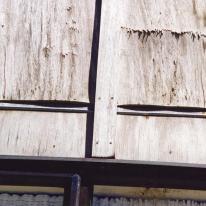Plywood cladding – delamination
Listed under: Exterior, timber and wood-based, plywood, cladding, walls, moisture, wall cladding, plywood sheets or planks
Cause
Thermal movement of timber
Repair
- if the problem appears within 10 years of the original installation, call back the original installer. Homeowners can take action for up to 10 years after building work is completed if implied warranties in the Building Act have not been met. These include that the materials used must be fit for purpose and the work must be done with reasonable care and skill
- it is important to determine the cause of the problem – for example, whether an inappropriate cladding material has been used, or the fixings are not appropriate. If you are not able to do this yourself, you could consult an experienced building surveyor
- if the problem is very minor, using cover boards and recoating the timber may be an appropriate short-term option. Scrape or sand back paint or stain, prime (if painting) and cover delaminated edges and/or corners with timber cover boards. Re-apply protective paint or stain using a lighter rather than a darker colour to reduce the likelihood of further timber movement
- if delamination is severe, replace the damaged sheets. If the cladding requires replacement within 15 years of its installation, it is likely that the replacement will require a building consent. If this is the case, and you want a builder to make the repairs/replacement for you, the work must be carried out or supervised by a licensed building practitioner
Cause
Effect of weathering or UV deterioration
Repair
- as for the first repair above.
- ensure that the materials used and any finishing work, such as coatings applied, are sufficient for the location and exposure of the building
Cause
Swelling/shrinkage due to moisture absorption
Repair
- as for the first repair above. It will be especially important to determine the causes of the moisture absorption and address those before making repairs. The cause could be cladding too close to the ground, gardens or paving built up against the cladding, damaged gutters that release rainwater down the cladding, overhanging trees that prevent the cladding drying out, and so on
- if the problem is severe or has been going on for an extended period of time, check whether there are problems with wall framing. If you are unable to do this yourself, consult an experienced building surveyor for advice





